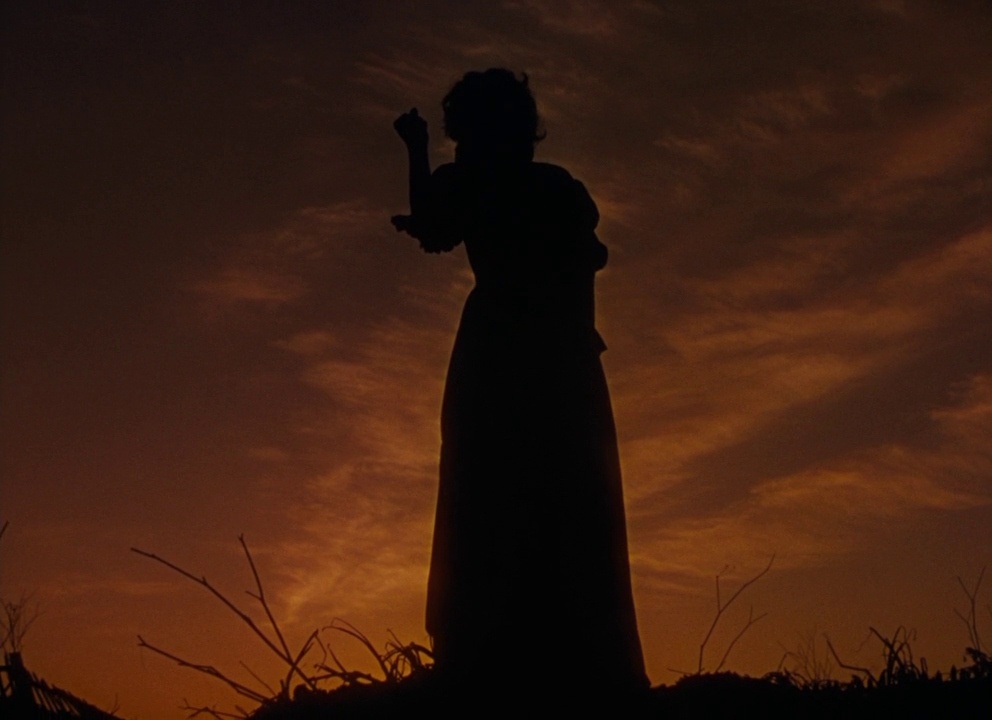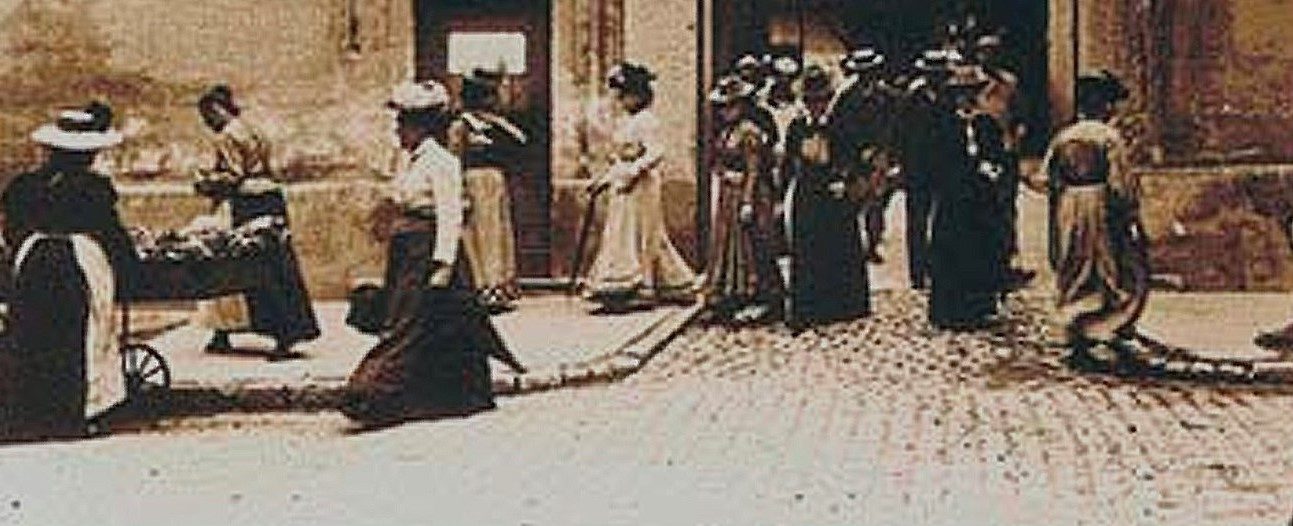United States, 1939
Directed by Victor Fleming, George Cukor, Sam Wood
With Vivien Leigh (Scarlett O’Hara), Leslie Howard (Ashley Wilkes), Olivia de Havilland (Melanie Hamilton-Wilkes), Clark Gable (Rhett Butler), Hattie McDaniel (Mammy)

She is the first lead character to appear on-screen and the film’s last shot shows her dark silhouette against an orange sky: this overambitious mix between a romance and a period piece, a coming-of-age tale and an epic narrates how a Southern belle, over a period of less than fifteen years covering the Civil War and the Reconstruction era in Georgia, is maturing from an impish teenager into a confident but saddened woman, who has long struggled to find love and to stay proud of her inheritance.
The first part of Scarlett O’Hara’s long-winded story intertwines her sentimental misfortune with the wider historical tragedy. Scarlett is infatuated with the heir of the plantation neighboring hers, Ashley Wilkes. But the young man wants to marry her cousin, Melanie Hamilton. Out of spite Scarlett marries another beau; but the rather dull fellow is killed in one of the first battles pitting the new-found Southern Confederacy against the rest of the United States. The war compels Scarlett to leave her plantation, which her father named Tara, and to go to Atlanta, especially to help Melanie who is now living over there, expecting a baby from her frontline-posted husband. Soon, the war wreaks havoc in the area and both women must flee. Scarlett hopes to take shelter at Ashley’s plantation and hers but the first place has been burnt while in Tara many servants have fled, crops have been lost, her mother has died and her father is now insane. And the end of the war means more misery.
If she has managed to get to Tara without much troubles, it is thanks to the gracious help of a roguish and yet fairly distinguished fellow, Rhett Butler, a Charleston-born businessman older than her and spurned by his own family. They first met the very day when Ashley explained to Scarlett he could not marry her and they cross paths regularly, always in an awkward manner: Rhett enjoys teasing Scarlett but seems more and more to be smitten by her impetuous character; she does not really like him but is still ready to follow him. Their complicated relationship defines the film’s second part.
Unfolding against the background of the Reconstruction, it first depicts the obstinate and increasingly unkind efforts Scarlett makes to restore her family’s wealth and influence, in particular thanks to her wedding with a former plantation heir who has become a successful shopkeeper and entrepreneur (never mind he was supposed earlier to marry of her sisters). Scarlett proves she is a fierce and clever businesswoman and puts on her payroll Ashley to help him – and to stay close to him no matter what. However the husband is killed in a political attack against Yankees. A widow for a second time, Scarlett eventually accepts to share her life with Rhett. Their marriage does make them happy for quite a time but her unwillingness to discard her feelings for Ashley and, more brutally, the death of her daughter in an equestrian accident put an end to their love affair. Rhett leaves her alone just after the death from illness of Melanie and Scarlett’s realization nothing can unite her with Ashley.
An adaptation of the highly successful, Pulitzer prize-winning, novel by Margaret Mitchell, the film is a personal project of the famed producer David O. Selznick who invested heavily in buying the rights of the book and then on shooting a screenplay that was not easy to finalize. The budget reached the four million US dollars mark, a stupendous sum at the time; the cast involved 50 speaking roles and 2,400 extras; half a million feet of film were shot, with the end product lasting some 220 minutes (there are variations between in the running time of the six different theatrical releases organized over the years for the movie). Reaching Selznick’s aesthetic goals exhausted three directors: George Cukor, who begged to differ with his boss and was fired as a consequence; Victor Fleming, who worked a lot to hold the project together, till he had to take a rest; and Sam Woods, who replaced Fleming for a few weeks. The efforts were worth the trouble: this is one of the most watched and revered films in history.
The stunning quality of the Technicolor and the sheer scope of the narration can explain this success; a year after “The Adventures of Robin Hood”, Fleming proves his full command of this new color technique and his flair for striking compositions. In particular, “Gone With the Wind” is replete with brilliant shots about the tragedy of war (some becoming iconic, like the bold crane shot showing Scarlett lost in endless rows of wounded as she is looking for a doctor to help Melanie deliver). But despite the powerful imagery and a few smart lines (courtesy Rhett Butler), the film’s take on the crucial historical event is rather perfunctory and biased.
History is just a convenient background to the main story, the difficult growing up of a young woman, as the selfish torments of the belle are engulfed in the wider horror of History. Events and characters are depicted according to the viewpoints and the prejudices of the Deep South, duly respecting the intent of the book (from the first intertitles to the last words) and avoiding any pointed criticism. Old-fashioned propriety and landed property are celebrated as paramount virtues (the only hope dangled to Scarlett at the end, when she is fully alone, is to come back to Tara, the only element in her life which can last). African Americans barely feature and act according to the stereotypical vision of the plantations; it may be argued that the big role given to Scarlett’s personal maid and former nurse, Mammy, helped improve the visibility of the Black people inside of the US cinema but Hattie McDaniel’s performance never challenges the moralistic and comical tenets defining her character and just remains another cog in the wheel running this big machine of an entertainment.
Scarlett’s tormented relationships with men, in particular Rhett, are full of funny twists and sad turns and narrated with such a sense of suspense and romance that her quest for love remains riveting through the stunningly meandering ways it follows. Yet the true partner helping Scarlett in her odyssey from brattish youth to somber adulthood is not wearing whiskers or mustaches.
Melanie is another Southern belle that has got the qualities Scarlett is famously lacking, from patience to gentleness, from self-sacrifice to full trust into people. She is first resented by Scarlett but the Atlanta experience slowly challenges Scarlett’s views: she must accept the strength and moral value of Ashley’s wife. She eventually does whatever it takes to help her deliver; it is a striking scene, with Scarlett at the center of the composition and shot against the light, speaking in a new tone; it seems she is also changing through the experience – visually, this image is eerily reminiscent of an earlier one featuring her and her dad against the light, as he convinces her of the importance of their estate. After the event, the first part is rushed along towards its end, with Scarlett kissing for the first time Rhett and coming back to Tara, compelled to work with her own hands to rebuild it – and once again, her anger person is back-lit, her dark outline brandishing against an orange sky a vengeful fist – this is a key motif that emphasizes the milestones her social life as an heir to a Southern estate.
It is Melanie’s death that brings the film to its heartbreaking end: Scarlett, at long last, understands how great the nobility and kindness of Melanie were and then accepts that her infatuation with Ashley was just an illusion. Over the second part, Melanie has been an unfailing supporter of Scarlett, helping her to keep her repute safe even when she has erred on the wrong side, in business as well as in sentiment. Melanie, remarkably played by Olivia de Havilland, who skillfully adheres to melodrama’s codes but avoids making her character’s traits sound too hallowed or too silly, is not so much a foil than a yardstick helping the audience to appreciate Scarlett’s evolution, the way her personality blossom. Scarlett learns to become more hard-headed in her dealings with the world and to give up her youthful illusions on love; her financial success bears witness to her skills as a woman forced by circumstances to pull herself by her bootstraps while her solitude at the end caps her selfish and naïve pursuit of happiness. This is nicely reflected by the way her attitudes and her clothes change over the course of the narrative, whose ponderous pace is offset by a constant light-hearted touch. The part, calling for endurance and gusto, is demanding but Vivien Leigh pulls it off.

